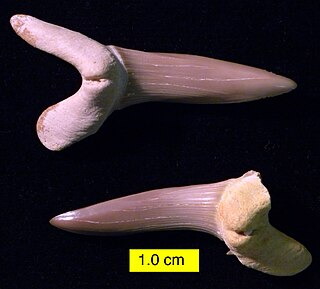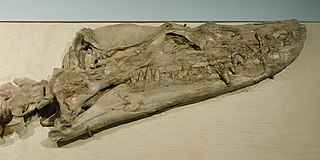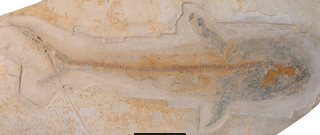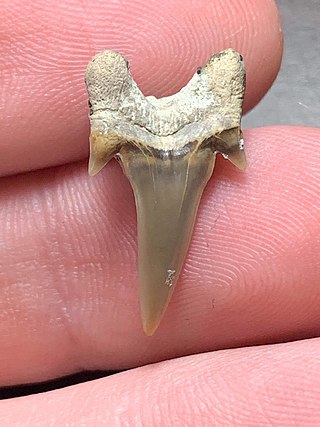
Squalicorax, commonly known as the crow shark, is a genus of extinct lamniform shark known to have lived during the Cretaceous period. The genus had a global distribution in the Late Cretaceous epoch. Multiple species within this genus are considered to be wastebasket taxon due to morphological similarities in the teeth.

Cretoxyrhina is an extinct genus of large mackerel shark that lived about 107 to 73 million years ago during the late Albian to late Campanian of the Late Cretaceous. The type species, C. mantelli, is more commonly referred to as the Ginsu shark, first popularized in reference to the Ginsu knife, as its theoretical feeding mechanism is often compared with the "slicing and dicing" when one uses the knife. Cretoxyrhina is traditionally classified as the likely sole member of the family Cretoxyrhinidae but other taxonomic placements have been proposed, such as within the Alopiidae and Lamnidae.

Scapanorhynchus is an extinct genus of goblin shark that lived during the Cretaceous period, from the Aptian to the end of the Maastrichtian. Later records, such as those from the Miocene assigned to the species S. subulatus, are highly dubious and may be misidentified sand sharks.

Otodus is an extinct, cosmopolitan genus of mackerel shark which lived from the Paleocene to the Pliocene epoch. The name Otodus comes from Ancient Greek ὠτ- and ὀδούς – thus, "ear-shaped tooth".

Protostegidae is a family of extinct marine turtles that lived during the Cretaceous period. The family includes some of the largest sea turtles that ever existed. The largest, Archelon, had a head one metre (39 in) long. Like most sea turtles, they had flattened bodies and flippers for front appendages; protostegids had minimal shells like leatherback turtles of modern times.

Styxosaurus is a genus of plesiosaur of the family Elasmosauridae. Styxosaurus lived during the Campanian age of the Cretaceous period. Three species are known: S. snowii, S. browni, and S. rezaci.

Ptychodus is a genus of extinct large durophagous (shell-crushing) lamniform sharks from the Cretaceous period, spanning from the Albian to the Campanian. Fossils of Ptychodus teeth are found in many Late Cretaceous marine sediments worldwide.

Apateodus is a genus of prehistoric marine ray-finned fish which was described by Woodward in 1901. It was a relative of modern lizardfish and lancetfish in the order Aulopiformes, and one of a number of prominent nektonic aulopiforms of Cretaceous marine ecosystems.

Bananogmius is an extinct genus of marine ray-finned fish that was found in what is now North America and Europe during the Late Cretaceous, from the Cenomanian to the Santonian. It lived in the Western Interior Seaway, which split North America in two during the Late Cretaceous, as well as the proto-North Sea of Europe.

Hybodontiformes, commonly called hybodonts, are an extinct group of shark-like cartilaginous fish (chondrichthyans) which existed from the late Devonian to the Late Cretaceous. Hybodonts share a close common ancestry with modern sharks and rays (Neoselachii) as part of the clade Euselachii. They are distinguished from other chondrichthyans by their distinctive fin spines and cephalic spines present on the heads of males. An ecologically diverse group, they were abundant in marine and freshwater environments during the late Paleozoic and early Mesozoic, but were rare in open marine environments by the end of the Jurassic, having been largely replaced by modern sharks, though they were still common in freshwater and marginal marine habitats. They survived until the end of the Cretaceous, before going extinct.

During the time of the deposition of the Niobrara Chalk, much life inhabited the seas of the Western Interior Seaway. By this time in the Late Cretaceous many new lifeforms appeared such as mosasaurs, which were to be some of the last of the aquatic lifeforms to evolve before the end of the Mesozoic. Life of the Niobrara Chalk is comparable to that of the Dakota Formation, although the Dakota Formation, which was deposited during the Cenomanian, predates the chalk by about 10 million years.

The Carlile Shale is a Turonian age Upper/Late Cretaceous series shale geologic formation in the central-western United States, including in the Great Plains region of Colorado, Kansas, Nebraska, New Mexico, North Dakota, South Dakota, and Wyoming.

Bonnerichthys is a genus of fossil fishes within the family Pachycormidae that lived during the Coniacian to Maastrichtian stage of the Late Cretaceous. Fossil remains of this taxon were first described from the Smoky Hill Member of the Niobrara Chalk Formation of Kansas, and additional material was later reported from the Pierre Shale, Mooreville Chalk, Demopolis Chalk, Wenonah Formation, and Moreno Formation, among other localities. It grew to at least 5 metres (16 ft) in total body length, substantially less than the related Leedsichthys from the Jurassic which likely grew up to 16.5 metres (54 ft).

Otodus chubutensis, meaning "ear-shaped tooth of Chubut", from Ancient Greek ὠτ and ὀδούς – thus, "ear-shaped tooth", is an extinct species of prehistoric megatoothed sharks in the genus Otodus, that lived during Oligocene, Miocene, and Pliocene, in ~28–5.3 milions years ago. The largest individuals were about 13.5 metres (44 ft) long. This shark is considered a close relative of the famous prehistoric megatoothed shark O. megalodon. However, as is the case with O. megalodon, the classification of this species is disputed.

Cardabiodon is an extinct genus of large mackerel shark that lived about 95 to 91 million years ago (Ma) during the Cenomanian to Turonian of the Late Cretaceous. It is a member of the Cardabiodontidae, a family unique among mackerel sharks due to differing dental structures, and contains the two species C. ricki and C. venator. Cardabiodon fossils have been found in Australia, North America, England, and Kazakhstan. It was likely an antitropical shark that inhabited temperate neritic and offshore oceans between 40° and 60° paleolatitude, similar to the modern porbeagle shark.

Meristodonoides is an extinct genus of hybodont known from the mid-late Cretaceous, with potential records dating back to the Jurassic. It is one of a number of hybodont genera composed of species formerly assigned to Hybodus.

Cretalamna is a genus of extinct otodontid shark that lived from the latest Early Cretaceous to Eocene epoch. It is considered by many to be the ancestor of the largest sharks to have ever lived, such as Otodus angustidens, Otodus chubutensis, and Otodus megalodon.
Megalolamna is an extinct genus of large mackerel shark that lived approximately 23.5 to 15 million years ago (Mya), from the Late Oligocene to the Middle Miocene epochs. Fossils belonging to this genus are known from the Americas, Europe and Japan, and have been documented in scientific literature since the late 19th century. It was in 2016 that the fossils were described as belonging to the same distinct taxon called M. paradoxodon. However, a 2024 study reveals that the taxon was already described indirectly in 1879 under the name Otodus serotinus, the only known species of this genus then being renamed as M. serotinus. It is a member of the Otodontidae, a family of large-toothed sharks known to include the contemporary megalodon.

The Kristianstad Basin is a Cretaceous-age structural basin and geological formation in northeastern Skåne, the southernmost province of Sweden. The basin extends from Hanöbukten, a bay in the Baltic Sea, in the east to the town of Hässleholm in the west and ends with the two horsts Linderödsåsen and Nävlingeåsen in the south. The basin's northern boundary is more diffuse and there are several outlying portions of Cretaceous-age sediments. During the Cretaceous, the region was a shallow subtropical to temperate inland sea and archipelago.

Archaeolamna is an extinct genus of mackerel sharks that lived during the Cretaceous. It contains three valid species which have been found in Europe, North America, and Australia. While it is mostly known from isolated teeth, an associated set of teeth, jaws, cranial fragments, and vertebrae of A. kopingensis is known from the Pierre Shale of Kansas. Teeth of A. k. judithensis were found with a plesiosaur skeleton with bite marks from the Judith River Formation of Montana. It was a medium-sized shark with an estimated total body length of 3–4 metres (9.8–13.1 ft).



















